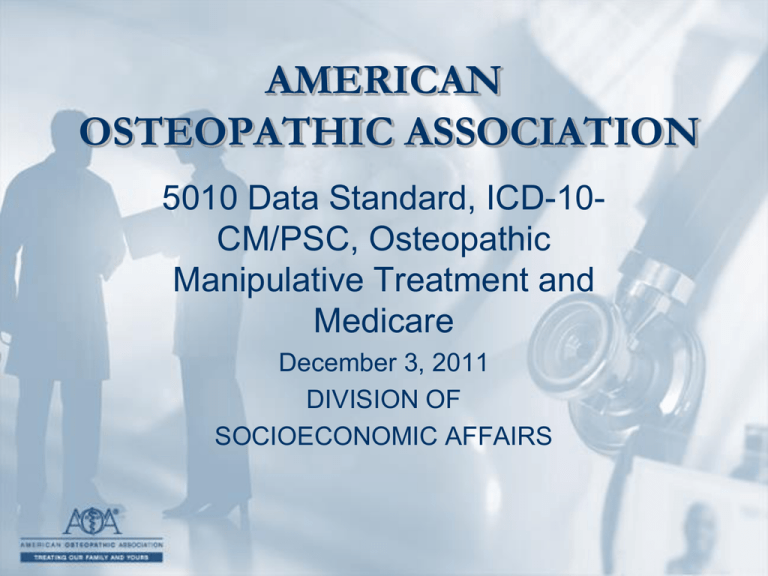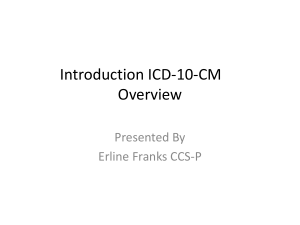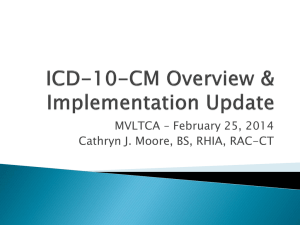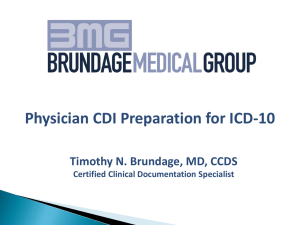ICD-10-CM - Indiana Osteopathic Association
advertisement

AMERICAN OSTEOPATHIC ASSOCIATION 5010 Data Standard, ICD-10CM/PSC, Osteopathic Manipulative Treatment and Medicare December 3, 2011 DIVISION OF SOCIOECONOMIC AFFAIRS Socioeconomic Affairs Staff • Yolanda Doss, MJ, RHIA, Director, Division of Socioeconomic Affairs • Sandra Peter, MHA Assistant Director, Clinical Practice Outreach • Michele Campbell, CPC, Coding & Reimbursement Specialist • Kavin Williams, CPC, CCP Health Reimbursement Policy Specialist Yolanda Doss, MJ, RHIA Responsibilities include: – Helping to secure reimbursement for osteopathic services – Securing the acceptance of osteopathic credentials – Addressing Medicare issues – HIPAA compliance – Fraud and Abuse Sandra Peters, MHA Responsibilities include: – Develop educational material on physician advocacy, manage care, quality and performance measures impacting osteopathic medicine – Design and manage a set of member services to enhance their manage care interactions and to promote their opportunities to participate in manage care – Provide update to the AOA leadership on health care trends particularly in the areas of pay for performance and physician profiling Kavin T. Williams, CPC, CCP Responsibilities include: – Assists AOA members with reimbursement and health payment policies. – Oversees and assists AOA members with coding and payment disputes with carriers. – Oversees the AOA Coding and Reimbursement Advisory Panel. – Represents the AOA at national reimbursement policy meetings. Are you ready for ICD 10 and the HIPAA 5010 Data Standard? • Objectives – To educate physicians on the ICD 10 and HIPAA 5010 implementation compliance dates – To educate physicians on the impact the new coding sets will have on the current reimbursement and coding structure The Transition to HIPAA 5010 • Have you heard of the HIPAA 5010 Data Standard? • Have you begun testing? • Will you be ready for January 1, 2012? Background of HIPAA 5010 Data Standard • The current version of the standards (4010/4010A1) are identified as lacking certain functionality for health care needs • Version 5010 will accommodate the ICD 10 codes Mark Your Calendars • Important dates for 5010 Implementation – January 1, 2011-begin external testing of the 5010 version for electronic claims – December 31, 2011-to be at level II compliance external testing of the 5010 for electronic claims must be completed – January 1, 2012 – All electronic claims must use Version 5010. Version 4010 claims will no longer be accepted Getting Started • Now is the time…. • Testing should be conducted both internally and externally with current business partners • Internal testing of version 5010 should have been completed by December 31, 2010 • External should be completed by December 31, 2011 Getting Started • Testing early will allow you to identify any potential issues, and address them in advance • As HIPAA covered entity, CMS has to ensure that its business processes, systems , policies and those of ist contractors, providers, health plans, etc. are compliant with HIPAA Pitfalls • Lack of testing with your vendors, clearing houses, insurers to ensure that you can accept and send transactions is probably the top barrier to success • Cost • Timing (deadlines) Summarize • Implementation date to be compliant for the 5010 HIPAA Data transaction is January 1, 2012 • If you have not begun testing the time is NOW!! • Contact your vendors to inquire/schedule your internal and external testing Vendor Model Letter • • • • • • • • • • • • • • Dear Vendor (Clearinghouse, EMR system, Medicare, private payers): My (name of practice)________________ uses your ___________________ product/services, version ___________. As ICD-10-CM implementation approaches, we would like some information and clarification about your plans to upgrade your systems. Specifically, we would like to know your plans for updating software to comply with HIPAA transactions. Can you provide a timetable for the following. When will you be installing upgrades and will there be a charge for this data? Will my practice need additional hardware or support services to install the upgrade(s)? Thank you in advance for complying with and your prompt attention to this request. Sincerely, ICD-10-CM/PCS History The International Classification of Diseases, Tenth Revision, Clinical Modification (ICD-10-CM) is the United States' clinical modification to the World Health Organization’s (WHO) International Classification of Diseases, Tenth Revision (ICD-10). ICD-10 was adopted by the World Health Assembly in 1990. Following the publication of ICD-10, a number of countries performed an analysis to determine if the WHO classification would meet their needs given the changes to the roles of ICD since the ninth revision. History The United States remains the only industrialized nation that has not yet implemented ICD-10 (or a clinical modification) for morbidity, meaning diseases or causes of illness typically coded in a healthcare facility. Since 1999, however, the US has used ICD-10 for mortality reporting – the coding of death certificates (typically done by a vital statistics office, not the healthcare facility). Implementing ICD-10-CM will maintain data comparability internationally and between mortality and morbidity data in the U.S. Development In 1994 under the leadership of the National Center for Health Statistics (NCHS), the United States began their process of determining whether an ICD10 modification should be developed. NCHS awarded a contract to the Center for Health Policy Studies to decide if a clinical modification was necessary. A Technical Advisory Panel (TAP) was formed and their recommendation was to create a clinical modification. In 1997, the entire draft of the Tabular List of ICD-10-CM and the preliminary crosswalk between ICD-9-CM and ICD-10-CM were made available on the NCHS website for public comments. The public comment period ran from December 1997 through February 1998. Since that time revisions were based on further study and the comments submitted. Draft versions of ICD-10-CM were made available in 2002, 2007, 2009, 2010, and 2011. Limited code updates will continue to occur to this draft prior to implementation of ICD-10-CM. Development While ICD-10 provides many more categories for diseases and other healthrelated conditions than previous revisions, the clinical modifications thus far to ICD-10 offer a higher level of specificity by including separate codes for laterality and additional character and extensions for expanded detail. In addition, other changes included combining etiology and manifestations, poisoning and external cause, or diagnosis and symptoms into a single code. ICD-10-CM also provides code titles and language that complement accepted clinical practice. ICD-10-CM codes have the potential to reveal more about quality of care, so that data can be used in a more meaningful way to better understand complications, better design clinically robust algorithms and better track the outcomes of care. ICD-10-CM incorporates greater specificity and clinical detail to provide information for clinical decision making and outcome research. ICD 10 • • • • • Implementation date is October 1, 2013 Benefits of ICD 10 Have you started preparation for ICD 10? How do I get started? How do I find the necessary resource information? Benefits of ICD 10 • The Benefits of ICD-10-CM • ICD-10-CM incorporates much greater clinical detail and specificity than ICD-9-CM. Terminology and disease classification have been updated to be consistent with current clinical practice. The modern classification system will provide much better data needed for: • Measuring the quality, safety, and efficacy of care; • Reducing the need for attachments to explain the patient’s condition; • Designing payment systems and processing claims for reimbursement; • Conducting research, epidemiological studies, and clinical trials; Benefits of ICD 10 • • • • • • • • Setting health policy; Operational and strategic planning; Designing health care delivery systems; Monitoring resource utilization; Improving clinical, financial, and administrative performance; Preventing and detecting health care fraud and abuse; and Tracking public health and risks. Non-specific codes still exist for use when the medical record documentation does not support a more specific code ICD 9 vs ICD 10 • Here are some SIMILARITIES AND DIFFERENCES BETWEEN THE TWO CODING SYSTEMS: • ICD-10-CM uses 3–7 alpha and numeric digits and full code titles, but the format is very much the same as ICD-9-CM (e.g., ICD-10CM has the same hierarchical structure as ICD-9-CM). • The 7th character in ICD-10-CM is used in several chapters (e.g., the Obstetrics, Injury, Musculoskeletal, and External Cause chapters). It has a different meaning depending on the section where it is being used (e.g., in the Injury and External Cause sections, the 7th character classifies an initial encounter, subsequent encounter, or sequelae (late effect)). Similarities & Differences cont’d • Primarily, changes in ICD-10-CM are in its organization and structure, code composition and level of detail ICD-9-CM • • • • • • 3–5 digits; First digit is alpha (E or V) or numeric (alpha characters are not case sensitive); Digits 2–5 are numeric; and Decimal is used after third character. Examples: 496 – Chronic airway obstruction, not elsewhere classified (NEC); 511.9 – Unspecified pleural effusion; and V02.61 – Hepatitis B carrier. ICD-10-CM • • • 3–7 digits; Digit 1 is alpha; Digit 2 is numeric; Digits 3–7 are alpha or numeric (alpha characters are not case sensitive); and • Decimal is used after third character. • Examples: A78 – Q fever; A69.21 – Meningitis due to Lyme disease; and S52.131A – Displaced fracture of neck of right radius, initial encounter for closed fracture. What will change? • Coding – Code set will increase from 17,000 to 140,000 therefore the code books and styles will completely change ( both ICD 10-Cm and ICD 10-PCS) – Clinical knowledge-Coders may need to be reeducated on anatomy and physiology – All staff who handle coding, from the front office staff to the practice manager Additional Changes • Laterality ( left, right, bilateral) • For example: – C50.511- Malignant neoplasm of lower-outer quadrant of right female breast – H16.013- Central corneal ulcer, bilateral – L89.012- Pressure ulcer of right elbow, stage II Changes Cont’d • Combination codes for certain conditions and common associated symptoms and manifestations – Example: • K57.21-Diverticulitis of large intestine with perforation and abscess with bleeding • E11.341- Type 2 diabetes mellitus with severe nonproliferative diabetic retinopathy with macular edema Changes Cont’d • Combination codes for poisonings and their associated external cause – Example • T42.3x25-Poisoning by barbiturates, intentional self-harm, sequela. (The ‘x’ character is used as a 5th character placeholder in certain 6 character codes to allow for future expansion and to fill in other empty characters (e.g, character 5 and/or 6) when a code that is less than 6 characters in length requires a seventh character Changes Cont’d • Example – T45.1x5A-Adverse effect of calcium-channel blockers, initial encounter – T15.02XD-Foreign body in cornea, left eye, subsequent encounter Inclusion of clinical concepts that do not exist currently in ICD-9-CM (e.g., underdosing, blood type, blood type, blood alcohol level) Changes cont’d Example T45.526D-Underdosing of antithrombotic drugs, subsequent encounter Z67.40-Blood alcohol level of 120-199 mg/100mL Expansion of codes Example-E10.610-Type 1 diabetes mellitus with diabetic neuropathic arthropathy Other changes in ICD 10 • Injuries are grouped by anatomical site as opposed to type of injury • Category restructuring and code reorganization have occurred in a number of ICD-10-CM chapters resulting in the classification of certain diseases and disorders that are different from ICD -9CM Other changes cont’d • Certain diseases have been reclassified to different chapters or sections in order to reflect current medical knowledge • New code definitions • Example-Acute Myocardial Infarction is now 4 weeks rather than 8 weeks • ICD-9-CM V codes (factors influencing health status and contact with health services) and E codes( External Causes of Injury and Poisoning) are incorporated in the main classification as opposed to being separated into supplementary classifications as they do currently in ICD-9-CM Documentation Is the Center Piece for Successful Reporting of ICD-10 Diagnosis Codes Why get started now • Due to the potential significant financial and clinical impact ICD-10 and the changes required for transition to the information systems that are being mandated, physicians should be taking steps now to understand how to successfully prepare for ICD-10 ICD-10 • Coding and billing systems will need to be updated to support the new code set • Currently the code set has 3-5 digits and ICD-10 will increase to 5-7 digits • Documentation will be impacted severely which will cause a domino effect from productivity to increased claims delays Steps to take to get started 2. Understand the potential impact this will have on physicians practice – Financial: How much will this transition cost a practice (training, software, etc) – Productivity: How significant will this be for a practices bottom line and for how long? – Education-what is needed and for whom is it needed (coders, billers, front office staff, lab personnel, etc) Quiz • • • • • • • • • True or false? V and E codes are supplemental classifications in ICD-10-CM. True or false? In ICD-10-CM, injuries are grouped by anatomical site rather than injury category. What is the maximum number of characters in ICD-10-CM? How many chapters does ICD-10-CM contain? True or false? The first modification to ICD-10 was published in 2001 True or false? The final rule, published in the Federal Register naming ICD-10CM as a new medical code set standard to replace the ICD-9-CM diagnosis codes, sets October 1, 2013 as the implementation for ICD-10. True or false? ICD-10-CM uses extensions in some sections to identify an initial encounter, subsequent encounter or sequelae. Which letter of the alphabet is not utilized in ICD-10-CM? The first character of an ICD-10-CM code is always an alphabetic letter. Osteopathic Manipulative Treatment (OMT) • • • • • • Reporting of OMT Services E/M Modifier-25 Documentation Compensatory Changes OMT Survey Osteopathic Manipulative Treatment (OMT) 1-2 Body Regions Involved Vignette A 25 yr. old female presents with right lower neck pain of two weeks duration. Somatic dysfunction of cervical and thoracic regions are identified on exam. Description of Pre-Service Work The physician determines which osteopathic techniques (eg, HVLA, Muscle energy, Counterstrain, articulatory, etc) would be most appropriate for this patient, in what order the affected body regions need to be treated and whether those body regions should be treated with specific segmental or general technique approaches. The physician explains the intended procedure to the patient, answers any preliminary questions, and obtains verbal consent for the OMT. The patient is placed in the appropriate potion on the treatment table for the initial technique and region(s) to be treated. Description of Intra-Service Work Patient is initially in the supine position on the treatment table. Motion restrictions of C6 and C7 are isolated through palpation and treated using muscle energy technique. Dysfunctions of T1 and T2 are treated using passive thrust (HVLA) technique. Patient position is changed as necessary for treatment of the individual somatic dysfunctions. Patient feedback and palpatory changes guide further technique application as appropriate. Description of Post-Service Work Post-care instructions related to the procedure are given, including side effects, treatment reactions, self-care, and follow-up. The procedure is documented in the medical record Osteopathic manipulative treatment (OMT) 9-10 body regions involved Vignette A 40 year old male presents with suboccipital headache, and pain in the neck, upper and lower back, left shoulder and chest, and right ankle. He was involved in a rear-end MVA two weeks ago. X-rays in the ED were negative. He has been taking prescribed analgesic and muscle relaxant medications with minimal improvement. On examination, somatic dysfunction is identified at the occipitoatlantal, left glenohumeral and right tibiotalar joints, as well as the cervical, thoracic, costal, lumbar, sacral and pelvic regions. Description of Pre-Service Work The physician determines which osteopathic techniques (eg, HVLA, Muscle energy, Counterstrain, articulatory, etc) would be most appropriate for this patient, in what order the affected body regions need to be treated and whether those body regions should be treated with specific segmental or general technique approaches. The physician explains the intended procedure to the patient, answers any preliminary questions, and obtains verbal consent for the OMT. The patient is placed in the appropriate position on the treatment table for the initial technique and region(s) to be treated. Description of Intra-Service Work Patient is initially in the supine position on the treatment table. Motion restrictions of identified joints are isolated through palpation and treated using a variety of techniques as follows: occipitoatlantal joint and sacrum are treated using muscle energy and counterstain techniques; right glenohumeral joint and pelvis are treated with articulatory technique; lumbar, thoracic, cervical and right ankle are treated with passive thrust (HVLA) technique; costal dysfunctions are treated using muscle energy technique. Patient position is changed as necessary for treatment of the individual somatic dysfunctions. Patient feedback and palpatory changes guide selection of further technique application as appropriate . Description of Post-Service Work Post-care instructions related to the procedure are given, including side effects, treatment reactions, self-care, and follow-up. The procedure is documented in the medical record OMT RVUs 2011 • 98925 = 0.45 • 98926 = 0.65 • 98927 = 0.87 • 98928 = 1.03 • 98929 = 1.19 2012 • 98925 = 0.46 • 98926 = 0.71 • 98927 = 0.96 • 98928 = 1.21 • 98929 = 1.46 Conversion Factor = $33.9764 Conversion Factor = $24.6712 Medicare The Objective is to Provide Information on the Following Topics: • • • • • Medicare 2012 Updates Evaluation & Management Medicare Audits Recovery Audit Contractors (RAC) “Incident To” Services Medicare 2012 Updates • Physician Fee Schedule is facing a 27.4 percent reduction • Physician Quality Reporting Initiative (PQRI) Bonus Payment 2% • E-Prescribing Bonus Payment 2% • OMT Survey Physician Documentation • • • • This is critical to your reimbursement If it was not documented it did not happen Clear and Legible, words to document by Chief complaint (this is the driver to most insurance auditors) • Familiarize yourself with your documentation style- is it 1995 guidelines that you follow or 1997? Documentation Guidelines • The medical record should be complete and legible. • The documentation of each patient encounter should include: – reason for the encounter and relevant history, physical examination findings and prior diagnostic test results; – assessment, clinical impression or diagnosis; – plan for care Documentation Guidelines [Cont.] • The patient’s progress, response to and changes in treatment, and revisions of diagnosis should be documented. • The CPT and ICD-9-CM codes reported on the health insurance claim form or billing statement should be supported by the documentation in the medical record. • Hospital visits should be included in the patient’s chart Evaluation & Management (E/M) Coding • Coding for office visits • Modifier usage when billing an E/M with a procedure (OMT) • Time Based Coding Chief Complaint (CC) • The chief complaint is a concise statement describing the symptom, problem, condition, diagnosis, physician recommended return, or other factors that is the reason for the encounter, usually stated in the “patient’s own” words. • Documentation Guidelines states that the medical record should clearly reflect the chief complaint Medical Necessity • This area is not black/white • There are numerous definitions of medical necessity • Linking the appropriate diagnosis to the appropriate procedure to support the necessity of the procedure performed is critical. • Medicare defines medical necessity as services or items reasonable and necessary for the diagnosis or treatment of illness or injury to improve the functioning of a malformed body member. Coding For Time • When is it appropriate to code for time? • What is the auditor looking for when they review a chart that was billed as time being the controlling factor? Tips For Verbiage When Billing For Time Example of correct documentation of time: • In your note it should read “ I spent 45 minutes with the patient and over 50% of that time was spent discussing … Example of incorrect documentation of time: • “I spent 45 minutes with the patient, discussed surgical options versus medical management. What Is An Audit? • An effective tool used by Medicare and other payors to recover monies lost to fraud and erroneous billings. Why Audits Are Initiated? • • • • • Suspicion (Billing Pattern) Outlier Physicians The Senior Patrol Whistleblowers Procedure Codes Who Are The Auditors? • • • • • The Office of the Inspector General (OIG) Medicare The Department of Justice (DOJ) The Federal Bureau of Investigation (FBI) Carriers Types of Audits • Prepayment Audits • Post-Payment Audits • Statistical Sampling Method What Auditors Look For? • Billing for services or supplies that were not provided. • Billing for non-allowable or non-covered services. • Altering claim forms to receive a higher payment amount. • Unbundling claims. How To Respond To A Request For Documentation • Reply to the audit notice in a timely fashion. • Gather and submit Only the requested documentation. • Be cooperative. • You may want to conduct an internal audit. How to Respond to the Audit Findings • If the findings are not favorable: • Attempt to discuss the findings with the reviewer. • If necessary request redetermination. • If necessary request a level one appeal. Medicare Recovery Audit Contractors (RACs) 71 RAC Legislation • The RAC program was created by the Medicare Prescription Drug, Improvement, and Modernization Act of 2003 which pays incentive fees to third-party auditors that identify and correct improper payments paid to healthcare providers in fee-for-service Medicare. • The Medicare Prescription Drug, Improvement, and Modernization Act of 2003 also requires permanent and nationwide RAC program by no later than 2010 72 The RAC Demonstration Project • The RAC demonstration project took place of New York, Florida, and California. • By 2010 the RAC covered all 50 states. RAC Program Mission • To detect and correct past improper payments, • To implement actions that will prevent future improper payments. • Providers can avoid submitting claims that don’t comply with Medicare rules • CMS can lower its error rate • Taxpayers & future Medicare beneficiaries are protected 74 The New RAC’s Are: • Diversified Collection Services, Inc. of Livermore, California, in Region A, initially working in Maine, New Hampshire, Vermont, Massachusetts, Rhode Island and New York. • CGI Technologies and Solutions, Inc. of Fairfax, Virginia, in Region B, initially working in Michigan, Indiana and Minnesota. • Connolly Consulting Associates, Inc. of Wilton, Connecticut, in Region C, initially working in South Carolina, Florida, Colorado and New Mexico. • HealthDataInsights, Inc. of Las Vegas, Nevada, in Region D, initially working in Montana, Wyoming, North Dakota, South Dakota, Utah and Arizona. Additional states will be added to each RAC region in 2009 Minimize Provider Burden • Limit the RAC “look back period” to three years – Maximum look back date is October 1, 2007 • RACs will accept imaged medical records on CD/DVD • Limit the number of medical record requests 76 Medical Record Limit Example • Outpatient Hospital – 360,000 Medicare paid services in 2007 – Divided by 12 = average 30,000 Medicare paid services per month – x .01 = 300 – Limit = 200 records/45 days (hit the max) 77 Summary of Medical Record Limits (for FY 2009) • Inpatient Hospital, IRF, SNF, Hospice – 10% of the average monthly Medicare claims (max 200) per 45 days per NPI • Other Part A Billers (HH) – 1% of the average monthly Medicare episodes of care (max 200) per 45 days per NPI 78 Summary of Medical Record Limits (for FY 2009) Continued • Physicians (including podiatrists, chiropractors) • Sole Practitioner: 10 medical records per 45 days per NPI • Partnership 2-5 individuals: 20 medical records per 45 days per NPI • Group 6-15 individuals: 30 medical records per 45 days per NPI • Large Group 16+ individuals: 50 medical records per 45 days per NPI – Other Part B Billers (DME, Lab, Outpatient hospitals) • 1% of the average monthly Medicare services (max 200) per NPI per 45 days 79 RAC Validation Contractor (RVC) • CMS has contracted with Provider Resources, Inc. of Erie, PA, to work as the Recovery Audit Contractor (RAC) Validation Contractor. • The RAC Validation Contractor (RVC) will work with CMS and the RAC to approve new issues the RACs want to pursue for improper payments, as well as perform accuracy reviews on a sample of randomly selected claims on which the RACs have already collected overpayment. • The RVC is another tool CMS will use to provide additional oversight and ensure that the RACs are making accurate claim determinations in the permanent program. For Additional Information on RAC • http://www.cms.hhs.gov/MLNMattersArti cles/downloads/MM6125.pdf • http://www.cms.hhs.gov/RAC/Downloads /RAC%20Evaluation%20Report.pdf • http://www.cms.hhs.gov/rac/ Medicare “Incident to” Physician Services The OIG reviews Medicare services that are “incident to” physicians services to determine the qualifications and appropriateness of the staff who performed them. Physician Defined The “physician” refers to physician or other practitioner (listed below), who are authorized to receive payment for services “incident to” his or her own services. • • • • • physician assistants nurse practitioners clinical nurse specialist nurse midwife, and clinical psychologist Professional Service • A direct, personal, professional service which is rendered by the physician • To meet the “incident to” guidelines, the physician must initiate the course of treatment, and • Conduct subsequent physician services to show ongoing involvement Coverage Requirements To be covered, service and supplies must be: • An integral, though incidental, part of the physician’s or on-physician practitioner’s professional services • Commonly furnished in a physician’s office or clinic • Furnished by the practitioner or auxiliary personnel under the physician’s direct supervision Supervision Requirements Direct physician supervision of auxiliary personnel is required. Auxiliary personnel: • any individual (employee, leased employee, or independent contractor) who is acting under the supervision of a physician • Auxiliary personnel include nurses, medical assistants, technicians, etc. Direct Supervision in the Office • Physician must be present in the office suite • Physician must be immediately available to assist if needed • Does not require that the physician be in the same room Direct Supervision in the Office Continued Scenarios that do not meet the direct supervision requirement: • Availability of a physician by telephone • Physician presence somewhere in an institution Documentation To support the use of the incident to provision, the documentation should clearly indicate: • Who performed the “Incident to” service • The physician’s presence in the office suite during the service/procedure Division Website • Go to www.do-online.org and sign onto DO-Online. – First time users will need their AOA member number to sign up. • On DO-Online, click on Practice Management for the division website. • There is also a Division email address: practicemanagement@osteopathic.org. What the DO-Online Practice Management Website has for You • Billing and Coding • E/M documentation • ICD-9-CM code updates • OMT information • Legal • Litigation fund • Updates on class action suits • CMS/Medicare – Links to local carrier information – Information on each CPT code – Enrollment information – CMS Medlearn – CCI link – Fee schedules, new and prior What the DO-Online Practice Management Website has for You • Preventive health services • Demonstration projects • CERT- fraud and abuse information • HIPPA • Managed care • Osteopathic Advocacy Resources Division CME Seminars • Conducted in conjunction with state associations and specialty colleges. • Seminars available include Medicare Compliance, HIPAA Privacy Compliance, and Documentation Guidelines and Coding Reimbursement. • Call Yolanda Doss, MJ, RHIA at 800-6211773 ext. 8187 or ydoss@osteopathic.org for info. Contact Information • Yolanda Doss 1-312-202-8187 ydoss@osteopathic.org • Sandra Peters 1-312-202-8088 speters@osteopathic.org • Kavin T. Williams, -312-202-8194 kwilliams@osteopathic.org






